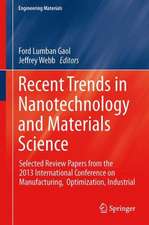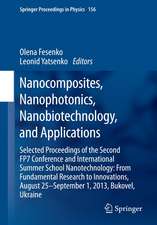Predictive Simulation of Semiconductor Processing: Status and Challenges: Springer Series in Materials Science, cartea 72
Editat de Jarek Dabrowski, Eicke R. Weberen Limba Engleză Paperback – 4 dec 2010
| Toate formatele și edițiile | Preț | Express |
|---|---|---|
| Paperback (1) | 1053.68 lei 38-44 zile | |
| Springer Berlin, Heidelberg – 4 dec 2010 | 1053.68 lei 38-44 zile | |
| Hardback (1) | 1233.97 lei 6-8 săpt. | |
| Springer Berlin, Heidelberg – 5 mai 2004 | 1233.97 lei 6-8 săpt. |
Din seria Springer Series in Materials Science
- 18%
 Preț: 1820.22 lei
Preț: 1820.22 lei - 18%
 Preț: 776.09 lei
Preț: 776.09 lei - 24%
 Preț: 689.68 lei
Preț: 689.68 lei - 18%
 Preț: 968.96 lei
Preț: 968.96 lei - 20%
 Preț: 568.94 lei
Preț: 568.94 lei - 18%
 Preț: 953.65 lei
Preț: 953.65 lei - 18%
 Preț: 902.36 lei
Preț: 902.36 lei - 18%
 Preț: 953.65 lei
Preț: 953.65 lei - 20%
 Preț: 948.41 lei
Preț: 948.41 lei - 18%
 Preț: 1143.07 lei
Preț: 1143.07 lei - 18%
 Preț: 1111.53 lei
Preț: 1111.53 lei - 18%
 Preț: 1103.62 lei
Preț: 1103.62 lei - 18%
 Preț: 1225.94 lei
Preț: 1225.94 lei -
 Preț: 473.91 lei
Preț: 473.91 lei - 18%
 Preț: 782.42 lei
Preț: 782.42 lei -
 Preț: 433.47 lei
Preț: 433.47 lei - 18%
 Preț: 1116.40 lei
Preț: 1116.40 lei - 18%
 Preț: 946.24 lei
Preț: 946.24 lei - 18%
 Preț: 945.20 lei
Preț: 945.20 lei - 15%
 Preț: 641.20 lei
Preț: 641.20 lei - 18%
 Preț: 958.56 lei
Preț: 958.56 lei - 18%
 Preț: 1224.36 lei
Preț: 1224.36 lei - 15%
 Preț: 644.82 lei
Preț: 644.82 lei - 24%
 Preț: 833.43 lei
Preț: 833.43 lei - 24%
 Preț: 1060.33 lei
Preț: 1060.33 lei - 18%
 Preț: 964.10 lei
Preț: 964.10 lei - 18%
 Preț: 1224.36 lei
Preț: 1224.36 lei - 18%
 Preț: 1221.20 lei
Preț: 1221.20 lei - 18%
 Preț: 946.87 lei
Preț: 946.87 lei - 18%
 Preț: 1836.92 lei
Preț: 1836.92 lei - 15%
 Preț: 643.34 lei
Preț: 643.34 lei - 18%
 Preț: 1246.32 lei
Preț: 1246.32 lei - 18%
 Preț: 956.81 lei
Preț: 956.81 lei - 18%
 Preț: 953.52 lei
Preț: 953.52 lei - 15%
 Preț: 637.59 lei
Preț: 637.59 lei - 24%
 Preț: 1060.87 lei
Preț: 1060.87 lei
Preț: 1053.68 lei
Preț vechi: 1386.42 lei
-24% Nou
Puncte Express: 1581
Preț estimativ în valută:
201.62€ • 211.07$ • 166.83£
201.62€ • 211.07$ • 166.83£
Carte tipărită la comandă
Livrare economică 01-07 aprilie
Preluare comenzi: 021 569.72.76
Specificații
ISBN-13: 9783642058042
ISBN-10: 3642058043
Pagini: 516
Ilustrații: XVII, 490 p. 177 illus., 16 illus. in color.
Dimensiuni: 155 x 235 x 27 mm
Greutate: 0.71 kg
Ediția:Softcover reprint of hardcover 1st ed. 2004
Editura: Springer Berlin, Heidelberg
Colecția Springer
Seria Springer Series in Materials Science
Locul publicării:Berlin, Heidelberg, Germany
ISBN-10: 3642058043
Pagini: 516
Ilustrații: XVII, 490 p. 177 illus., 16 illus. in color.
Dimensiuni: 155 x 235 x 27 mm
Greutate: 0.71 kg
Ediția:Softcover reprint of hardcover 1st ed. 2004
Editura: Springer Berlin, Heidelberg
Colecția Springer
Seria Springer Series in Materials Science
Locul publicării:Berlin, Heidelberg, Germany
Public țintă
ResearchCuprins
1 Transistors and Atoms.- 2 Atomistic Simulations of Processes at Surfaces.- 3 Atomistic Simulations in Materials Processing.- 4 Atomistic Simulation of Decanano MOSFETs.- 5 Modeling and Simulation of Heterojunction Bipolar Transistors.- 6 Gate Oxide Reliability: Physical and Computational Models.- 7 High-K Dielectrics: The Example of Pr2O3.- 8 Atomistic Simulation of Si3N4 CVD from Dichlorosilane and NH3.- 9 Interconnects and Propagation of High Frequency Signals.- 10 Modeling of Electromigration in Interconnects.- 11 Predictive Modeling of Transition Metal Gettering: Applications and Materials Science Challenges.
Recenzii
From the reviews:
"This book presents an in-depth discussion of our current understanding of key processes and identifies areas that require further work in order to achieve the goal of a comprehensive, predictive process simulation tool. Eleven contributions make up the book; each is supported by a wealth of references. … A valuable reference and guide to have on the shelf for frequent use and study. Certainly, the expertise and research experience of the contributors cannot be questioned. Summing up ... a richly rewarding work." (Current Engineering Practice, Vol. 47 (3), 2004-2005)
"This book presents an in-depth discussion of our current understanding of key processes and identifies areas that require further work in order to achieve the goal of a comprehensive, predictive process simulation tool. Eleven contributions make up the book; each is supported by a wealth of references. … A valuable reference and guide to have on the shelf for frequent use and study. Certainly, the expertise and research experience of the contributors cannot be questioned. Summing up ... a richly rewarding work." (Current Engineering Practice, Vol. 47 (3), 2004-2005)
Notă biografică
J. Dabrowski: Born in Warsaw, Poland, Sept. 29, 1958. PhD, Institute of Physics of the Polish Academy of Science (IF PAN), Warsaw, 1989. Scientific staff member IF PAN 1983-1992; postdoctoral fellow Fritz Haber Inbstitute of the Max Planck Society, Berlin, Germany, 1990-1991; postdoctoral fellow Xerox Palo Alto Research Center, California, 1992; since 1993 with IHP-microelectronics, Frankfurt (Oder), Germany. Conference series chairman, Challenges in Predictive Process Simulation (1997, 2000, 2002); international advisory commmittee member, International Training Institute for Materials Science, Hanoi, Vietnam. Project leader, German Research Society (1998-2000); von Neuman Institute for Computing (since 1993). Author (monograph), "Silicon surfaces and formation of interfaces; basic science in the industrial world" (World Scientific, 2000). Editor (book) , ""Recent Developments in Vacuum Science and Technology" (Research Signpost, 2003). Research in atomic diffusion mechanism in solid state; atomic structure of surfaces and semiconductor/dielectric interfaces; atomic structure of defects in semiconductors and insulators; signal processing for telecommunication. Achievements include discovery of atomic structure of the clean Si(113) surface; atomic structure of the main electron trap in GaAs (EL2 defect); atomic structure of the interface between a high-K dielectric (Pr2O3) and Si(001). Patents for silicon microelectronic technology; patents pending for telecommunication.
Textul de pe ultima copertă
Predictive simulation of semiconductor processing enables researchers and developers to extend the scaling range of semiconductor devices beyond the parameter range of empirical research. It requires a thorough understanding of the basic mechanisms employed in device fabrication, such as diffusion, ion implantation, epitaxy, defect formation and annealing, and contamination. This book presents an in-depth discussion of our current understanding of key processes and identifies areas that require further work in order to achieve the goal of a comprehensive, predictive process simulation tool.
Caracteristici
Detailed and up-to-date explanation of the key processes in semiconductor technology and their computational simulation Includes supplementary material: sn.pub/extras















